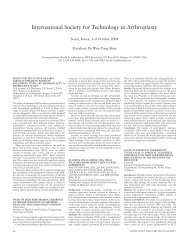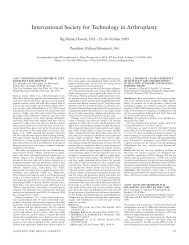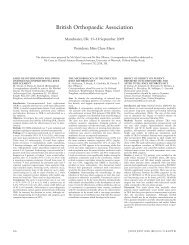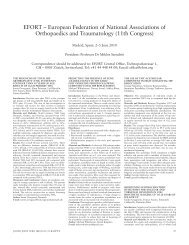Procs III 2011.indb - Journal of Bone & Joint Surgery, British Volume ...
Procs III 2011.indb - Journal of Bone & Joint Surgery, British Volume ...
Procs III 2011.indb - Journal of Bone & Joint Surgery, British Volume ...
You also want an ePaper? Increase the reach of your titles
YUMPU automatically turns print PDFs into web optimized ePapers that Google loves.
340 HELLENIC ASSOCIATION OF ORTHOPAEDIC SURGERY AND TRAUMATOLOGY<br />
release <strong>of</strong> the ulnar nerve with or without partial medial<br />
epicondylectomy and the anterior transposition and<br />
release respectively.<br />
Material and Method: From 1991 since 2008, 119<br />
patients, (81 men and 38 women) with an average<br />
age <strong>of</strong> 51(13-72 years) years were treated surgically<br />
for ulnar nerve compression at the elbow. The average<br />
duration <strong>of</strong> symptoms before surgery was 15 months<br />
(2- 48 months). Preoperatively 2 patients were grade I,<br />
52 patients were grade IIA, 31 patients were IIB and<br />
34 were grade <strong>III</strong> according to the modifi ed McGowan<br />
score. We performed in-situ decompression <strong>of</strong> the ulnar<br />
nerve in 35 patients, release with partial medial epicondylectomy<br />
in 44 patients and release with anterior transposition<br />
<strong>of</strong> the nerve in 40 patients.<br />
17 patients were lost to follow-up. 108 patients were<br />
clinically assessed.Comparing the results among different<br />
surgical procedures, an improvement <strong>of</strong> at least<br />
one McGowan grade was obtained in 26 <strong>of</strong> 30 patients<br />
treated with simple decompression, in 29 <strong>of</strong> 35 patients<br />
treated with release and anterior transposition <strong>of</strong> the<br />
nerve and in 38 <strong>of</strong> 43 patients treated with release and<br />
medial epicondylectomy.<br />
The results <strong>of</strong> this study show that the possibility for<br />
complete recovery is inversely related to the initial neuropathy<br />
grade. Partial medial epicondylectomy is a valuable<br />
surgical procedure for treating grade I to IIB ulnar<br />
neuropathy because is an anatomic method with minimal<br />
nerve manipulation preserving regional blood supply.<br />
006 TREATMENT OF THE CLOSED<br />
FRACTURES OF METACARPALS AND<br />
PHALANGES. COMPARISON BETWEEN<br />
KIRSCHNER WIRES AND MINI EXTERNAL<br />
FIXATION<br />
K. Makridis, M. Georgoussis, V. Mandalos, N.<br />
Daniilidis, S. Kourkoubellas, L. Badras<br />
Orthopaedic Department, General Hospital,<br />
Volos, Greece<br />
Fractures <strong>of</strong> metacarpals and phalanges are common in<br />
hand injuries. The goal <strong>of</strong> treatment is the immediate<br />
mobilization <strong>of</strong> the fi ngers and restoration <strong>of</strong> the hand<br />
anatomy thus avoiding contractures <strong>of</strong> the metacarpophalangeal<br />
and phalangophalangeal joints and hand<br />
dysfunction. The aim <strong>of</strong> this study is the comparison<br />
between two methods <strong>of</strong> fi xation <strong>of</strong> these fractures.<br />
Between 2000–2007, 74 patients who suffered metacarpophalangeal<br />
fractures were treated by K-wires<br />
and 62 patients were treated by mini external fi xation.<br />
Parameters recorded were the operating time, postoperative<br />
range <strong>of</strong> motion, cost and complications. The<br />
surgical time was lesser with the use <strong>of</strong> K-wires, the<br />
operative technique much simple and the cost minimum<br />
as compared to mini external fi xators. The postoperative<br />
range <strong>of</strong> motion was inferior with the external fi xation.<br />
However, there was no statistical difference between the<br />
two groups. 2 patients with the external fi xation and<br />
1 patient with K-wires developed pin-track infection.<br />
There were 3 failures <strong>of</strong> fi xation in the external fi xator<br />
group but no failure occurred with the use <strong>of</strong> K-wires.<br />
The majority <strong>of</strong> the fractures healed within 6 weeks.<br />
K-wires seem to be the ideal method <strong>of</strong> treatment<br />
considering the fractures <strong>of</strong> metacarpals and phalanges.<br />
The use <strong>of</strong> mini external fi xation presents many disadvantages<br />
and probably is restricted to the treatment <strong>of</strong><br />
the open and comminuted hand fractures.<br />
007 REDUCTION OF ACUTE ANTERIOR<br />
DISLOCATION: A PROSPECTIVE<br />
RANDOMIZED COMPARATIVE STUDY<br />
COMPARING A NEW TECHNIQUE WITH<br />
HIPPOCRATES AND KOCHER METHODS<br />
F. Sayegh, E. Kenanidis, M. Potoupnis,<br />
K.Papavasiliou, St. Pellios, G. Kapetanos<br />
3rd Orthopaedic Clinic <strong>of</strong> Aristotle University <strong>of</strong><br />
Thessaloniki –G.H. “Papageorgiou”, Greece<br />
Aim <strong>of</strong> this prospective, randomized study is to introduce<br />
and compare a new technique <strong>of</strong> reduction <strong>of</strong> the anterior<br />
dislocation <strong>of</strong> the shoulder with the “Hippocrates”<br />
and “Kocher” methods, as far as its effi cacy, safety and<br />
intensity <strong>of</strong> the pain felt by the patient during the reduction,<br />
are concerned. This is the fi rst reported prospective,<br />
randomized comparative study <strong>of</strong> three reduction<br />
techniques <strong>of</strong> anterior dislocations <strong>of</strong> the shoulder.<br />
154 patients suffering from acute anterior shoulder<br />
dislocation participated in the study. Patients were randomly<br />
assigned to one <strong>of</strong> the three study groups (New,<br />
“Hippocrates” and “Kocher”) and underwent reduction<br />
<strong>of</strong> their dislocation performed by residents orthopaedic<br />
surgeons.<br />
The groups were statistically comparable (age, male/<br />
female ratio, mechanism <strong>of</strong> dislocation, mean time interval<br />
between injury and fi rst attempt <strong>of</strong> reduction).<br />
Reduction was achieved with the “Fares” method<br />
in 88.6%, with the “Hippocrates” in 72.5% and<br />
with the “Kocher” in 68% <strong>of</strong> the patients. This difference<br />
was statistically signifi cant, favoring the new<br />
method (p=0.033). The mean duration <strong>of</strong> the reduction<br />
(p=0.000) and the mean reported by the patients VAS<br />
with the new method (p=0.000) were also statistically<br />
signifi cantly lower than those <strong>of</strong> the other methods. No<br />
complications were noted in any group.<br />
The new method seems to be more effective, faster<br />
and less painful method <strong>of</strong> reduction <strong>of</strong> the anterior<br />
shoulder dislocation, when compared with the “Hippocrates”<br />
and the “Kocher” methods. It is easily performed<br />
by only one physician and it is not more morbid<br />
that the other two methods.<br />
008 FUNCTIONAL OUTCOME AFTER<br />
SURGICAL EXCISION OF HETEROTOPIC<br />
OSSIFICATION ABOUT THE ELBOW IN ICU<br />
PATIENTS<br />
G.I. Mitsionis, A.V. Korompilias, M.G. Lykissas,<br />
D. Nousias, G. Mataliotakis, A.E. Beris<br />
Department <strong>of</strong> Orthopaedic <strong>Surgery</strong>, University <strong>of</strong><br />
Ioannina School <strong>of</strong> Medicine, Ioannina, Greece<br />
The objective <strong>of</strong> this study was to evaluate the functional<br />
outcome <strong>of</strong> the elbow joint in patients with heterotopic<br />
ossifi cation <strong>of</strong> the elbow joint who underwent surgical<br />
excision <strong>of</strong> pathologic bone.<br />
From 5/1994 to 12/2006, 24 patients (33 joints) with<br />
heterotopic ossifi cation <strong>of</strong> the elbow joint were evaluated.<br />
All patients were attended in the Intensive Care Unit<br />
(ICU). The patient\’s age ranged from 19-48 years (mean;<br />
32 years) The median ICU hospitalization was 3 weeks.<br />
In nine patients both elbows were affected. Unilateral<br />
involvement was equally noticed to the right (seven cases)<br />
and the left elbow (eight cases). The DASH SCORE and<br />
the range <strong>of</strong> motion were used for the evaluation <strong>of</strong> the<br />
results.All patients underwent surgical treatment in order<br />
to extract heterotopic bone and to improve the range <strong>of</strong><br />
motion <strong>of</strong> the affected elbow joint.<br />
Postoperatively 18 out <strong>of</strong> 33 operated elbow joints<br />
(54.54%) demonstrated improvement <strong>of</strong> the range <strong>of</strong><br />
motion, whereas no improvement was observed in the<br />
remaining 15 elbow joints (45.45%). Higher DASH<br />
SCORE was obtained in 19 out <strong>of</strong> 24 patients (79.17%).<br />
Surgical excision <strong>of</strong> the ectopic bone around the affected<br />
elbow signifi cantly improves the range <strong>of</strong> motion <strong>of</strong> the<br />
joint providing better use <strong>of</strong> the upper extremity and<br />
therefore a superior quality <strong>of</strong> life in these patients.<br />
009 CONGENITAL PSEUDARTHROSIS<br />
OF THE RADIUS TREATED WITH FREE<br />
VASCULARIZED FIBULAR GRAFT. A CASE<br />
REPORT WITH A LONG-TERM FOLLOW-UP<br />
A.E. Beris, M.G. Lykissas, I. Kostas, T.<br />
Vasilakakos, M.D. Vekris and A.V. Korompilias<br />
Department <strong>of</strong> Orthopaedic <strong>Surgery</strong>, University <strong>of</strong><br />
Ioannina School <strong>of</strong> Medicine, Ioannina, Greece<br />
We present a case <strong>of</strong> a 19-year-old white female patient<br />
with neur<strong>of</strong>i bromatosis type I who, 10 years ago, underwent<br />
free vascularized fi bular grafting for isolated congenital<br />
pseudarthrosis <strong>of</strong> her left radius.<br />
An external fi xator was applied for gradual distraction<br />
and correction <strong>of</strong> the deformity <strong>of</strong> the pseudarthrosic site<br />
for fi ve weeks. Wide resection <strong>of</strong> pseudarthrosis with sur-<br />
rounding fi brotic and thick scar tissue and bridging <strong>of</strong><br />
the gap with a free vascularized fi bular graft followed.<br />
Four months postoperatively, union was established in<br />
both graft ends. At the last follow-up, 10 years postoperatively,<br />
the patient has excellent function with full wrist<br />
fl exion-extension and forearm pronation-supination.<br />
Free vascularized fi bula transfer is considered the<br />
treatment <strong>of</strong> choice for congenital radial pseudarthrosis.<br />
It allows complete excision <strong>of</strong> the pathologic tissue and<br />
covering <strong>of</strong> the gap in one operation. Due to the vascularity<br />
<strong>of</strong> the free vascularized fi bular graft both sides <strong>of</strong><br />
fi bula unite easily with no additional intervention.<br />
010 SEVERE POST-TRAUMATIC<br />
ELBOW LESIONS TREATED WITH<br />
SEMI-CONSTRAINED TOTAL ELBOW<br />
ARTHROPLASTY<br />
I.Ignatiadis, D. Arapoglou, E. Pateromihelakis,<br />
P. Psyllakis, N.Hatzinikolaou, E.Pananis, N.<br />
Gerostathopoulos<br />
Dept. <strong>of</strong> Upper limb-Hand <strong>Surgery</strong> and<br />
Microsurgery KAT General Hospital, Athens,<br />
Greece<br />
To show the role and effectiveness <strong>of</strong> semi-constrained<br />
total elbow arthroplasty in restoring elbow function in<br />
severe, irreversible post-traumatic osseous and chondral<br />
injuries.<br />
Eighteen patients, aged 19-80, 11 male and 7 female,<br />
suffering from serious, irreversible anatomical and functional<br />
lesions <strong>of</strong> the elbow joint due to previous severe<br />
untreated or inadequately treated fractures (T-type<br />
transcondylar, trochlear-condylar, open fxs with large<br />
bony defects, severe osteochondral, heterotopic ossifi cation<br />
in ICU fracture patients). Post-op follow up was<br />
9–57 months.<br />
All patients were treated with modular, cemented,<br />
semi-constrained linked total elbow arthroplasty. A<br />
functional brace was used post-operatively, and motion<br />
was permitted on the 3rd post-op day. The patients were<br />
allowed a full range <strong>of</strong> motion at 1 week post-op and<br />
they were subjected to vigorous physiotherapy.<br />
Post-op results were evaluated by using Mayo, DASH,<br />
quick-DASH scores and measuring grip strength and<br />
range <strong>of</strong> motion. Our results ranged from satisfactory<br />
to excellent in 16 patiens, with good strength and wide<br />
motion arc (with up to 15o extension-fl exion defi cit).<br />
One old female patient suffered a severe cerebral stroke<br />
with a bad outcome. In another young male patient the<br />
motion arc reached only 40% <strong>of</strong> the normal (spasticity,<br />
ICU patient with brain injury).<br />
Semi-constrained linked total elbow arthroplasty<br />
proves to be an effective method <strong>of</strong> treatment in severe,<br />
irreversible, intraarticular post-traumatic elbow injuries<br />
with chondral destruction and grave functional defi cit,<br />
provided the proper technique is employed and a vigorous<br />
rehabilitation program is followed.<br />
011 MECHANICAL BEHAVIOR OF THE<br />
RADIOCARPAL JOINT DURING THE<br />
HEALING PROCESS OF A SCAPHOID<br />
FRACTURE<br />
F.N.Xypnitos, E.Kolliakou, D. T.Venetsanos, C. G.<br />
Provatidis, N. E. Efstathopoulos<br />
Second Department <strong>of</strong> Orthopaedics, Athens<br />
University Medical School, Athens, Greece;<br />
Radiology Department, Konstantopoulio<br />
Hospital, Nea Ionia, Athens, Greece; National<br />
Technical University <strong>of</strong> Athens, School <strong>of</strong><br />
Mechanical Engineering Mechanical Design and<br />
Control Systems Section, Laboratory <strong>of</strong> Dynamics<br />
and Structures, Athens, Greece<br />
The aim <strong>of</strong> the study was to investigate, fi rstly, the force<br />
distribution between scaphoid/radius and lunate/radius<br />
in the normal wrist and in the presence <strong>of</strong> a scaphoid<br />
fracture, secondly, how stresses and strains at the<br />
fractured area change during the healing process and<br />
thirdly, how the direction <strong>of</strong> the applied forces affects<br />
load transmission.<br />
A 3D fi nite element model <strong>of</strong> the normal wrist was<br />
J BONE JOINT SURG [BR] 2011; 93-B:SUPP <strong>III</strong>








